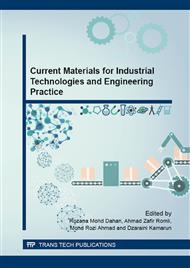[1]
S.K. Akhtar. and S. Huang. Continuum Theory of Plasticity. John Wiley & Sons (1995).
Google Scholar
[2]
V. Boljavonic. Sheet Metal Forming Processes and Die Design . Industrial Press, (2004) pp.64-67.
Google Scholar
[3]
I. Burchitz, Springback Improvement of its Predictability, Literature Study Report, Netherland Institute for Metals Research (2005).
Google Scholar
[4]
J. Cao, Z.H. Liu and W.K. Liu . Prediction of Springback in Straight Flanging Operation. Submitted to Symposium Advances in Sheet Metal Forming. IMECE '99 (1999).
Google Scholar
[5]
D.J. Crisbon, Experimental Measurement and Finite Element Simulation of Springback in stamping Aluminium Alloy Sheet for Auto-Body Panel Application, Master of Science Thesis, Department of Mechanical Engineering , Missisppi State University Science (2003).
Google Scholar
[6]
P.G. Cristopher, Springback of Simple Mechanical Test Specimen: Comparison between theory and finite elemnt predictions obtained using LS-DyNA and Dynaform, PHD of Eng. Thesis, Metal Forming Analysis Corparation, Kingston, Ontario, Canada (2004).
Google Scholar
[7]
M. Firat, U-channel forming analysis with an emphasis on springback deformation, Journal of Material and Design, Elsevier. 28 (2007) 147-154.
DOI: 10.1016/j.matdes.2005.05.008
Google Scholar
[8]
D. Fionn and P. Nik, Introduction to Computational Plasticity. Oxford University Press, (2004) pp.11-180.
Google Scholar
[9]
W. Gan, S.S. Babu, N. Kapustka and H. Robert, Microstructure Effects on the Springback of Advanced High-Strength Steel, Journal Of Metallurgical and Materials Transactions A, Volume 37, Number 11/November, (2006).
DOI: 10.1007/bf02586157
Google Scholar
[10]
S. Haryanti. Explicit and Implicit Time Integration in the Finite Element Modeling of Metal Forming Process, Journal Ilmiah Mesin Universitas Trisakti Vol. 9, No. 4, (2007).
Google Scholar
[11]
W. F. Hosford and M.C. Robert, Metal forming-mechanics and metallurgy. Prentice Hall, (1993).
Google Scholar
[12]
J. J. Jeswiet, M. Geiger , U. Engel, M. Kleiner, M. Schikorra, J. Duflou, R. Neugebauer, P. Bariani and S. Bruschi. Metal Forming Progress Since 2000. CIRP Journal of Manufacturing Science and Technology 1 (2008) 2–17.
DOI: 10.1016/j.cirpj.2008.06.005
Google Scholar
[13]
G.B. Kenneth and K.B. Michael, Engineering Material, Properties and Selection (6th ed). Prentice Hall, 1999, pp.354-407.
Google Scholar
[14]
K.P. Li, W.P. Carden and R.H. Wagoner, Simulation of Springback. International Journal of Mechanical Science, (2002), 44(1): 103-122.
DOI: 10.1016/s0020-7403(01)00083-2
Google Scholar
[15]
Y.C. Liu, Springback Reduction in U-channel: Double Bend Technique. Jounal of Applied Metalworking. (1984) , Vol. 3, pg 148-156.
DOI: 10.1007/bf02833694
Google Scholar
[16]
LS-DYNA Kyword Users Manual version 960, Livermore Software Technology Corporation, (2001).
Google Scholar
[17]
Z. Marciniak, J.L. Duncan and S.J. Hu, Mechanics of Sheet Metal Forming. Butterworth Heinemann, (2002), pp.1-13, pp.14-27, pp.30-43.
Google Scholar
[18]
K. Mohd Nizam, Optimising Deep Drawing Process Parameter using FE simulation . Master of Mechanical Engineering Thesis, Department of Mechanical and Manufacturing Engineering , Universiti Tun Hussien Onn Malaysia (2008).
DOI: 10.15282/jmes.11.2.2017.12.0246
Google Scholar
[19]
G. Monfort and A. Bragard . A Simple Model of Shape Errors in Forming and its Application to the Reduction of Springback. Springer Link Journal of Applied Metalworking Volume 4, Number 3 / July, 1986 pg 283-291.
Google Scholar
[20]
N. Song, D. Qian, C. Jian, K.L. Wing and L. Shaofan. Effective Models for Prediction of Springback in Flanging. ASME Journal of Engineering Materials and Technology (2004) Volume 123, Issue 4, 456.
Google Scholar
[21]
Z. Xiaoding, M. Zhaohui. and W. Li. Current Status of Advanced High Strength Steel for Auto-making and its Development in Baosteel. Baosteel Research Institute, Shanghai 201900, China (2007).
Google Scholar
[22]
International Iron & Steel Institute (2006). Advanced High Strength Steel Application Guidelines,. Version 3.
Google Scholar
[23]
Material Data Sheet of Dual Phase Steel (2005).
Google Scholar


